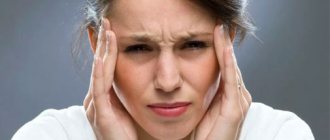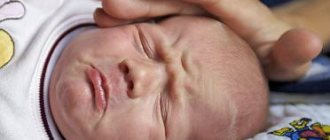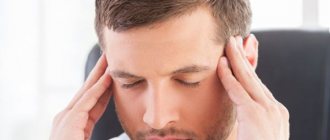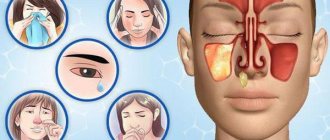Causes of headaches in the crown area
Among the causes of parietal headaches are acute and chronic diseases of the hearing organ, nerves, muscles and joints, as well as the vascular system. Vital organs are concentrated in the area behind the ears, so ignoring painful sensations is dangerous. You should pay attention to the time of occurrence and nature of the headache in the crown, its intensity - this information is important for the attending physician during diagnosis.
Diseases of the hearing organ
If the parietal part of the head hurts on one or both sides, a hearing test must be performed. It has a complex structure, and disorders or inflammatory processes in any area can lead to painful sensations behind the ears. The difficulty of the examination lies in the fact that the internal parts of the hearing organ are not visible to the naked eye even when using standard diagnostic techniques. However, new diagnostic methods make it possible to accurately determine the cause of pain in the parietal part of the head associated with diseases of the hearing organ.
Otitis
Otitis is an inflammation of the ear in any of its parts. The cause of the disease can be injury, bacterial infection, or mechanical blockage of the ear canal. In children, chronic otitis media is often caused by hypertrophy (abnormal growth) of the adenoids. Inflammation can be acute or chronic, aseptic or purulent. It is important to treat the disease in a timely manner, since otitis often becomes chronic and worsens with hypothermia or colds, and also causes hearing impairment.
There are several types of otitis, depending on the location of the inflammatory process:
- Otitis externa - affects the ear canal and the outer surface of the eardrum, rarely spreading to the auricle. This is the most common and safest type and can be easily treated with ear drops. The pain becomes more severe when opening the mouth.
- Otitis media is an inflammation of the auditory tube and other components of the middle ear. The disease is accompanied by acute pain, which often intensifies at night. Patients also complain of a sharp deterioration in hearing, pain in the temples and frontal part of the head, noise and ringing in the ears.
- Internal otitis (labyrinthitis) is a rare, but most dangerous type. If the process spreads to the inner ear, it can lead to inflammation of the auditory nerve and hearing loss. Treatment is complex and includes a course of antibiotics, anti-inflammatory and painkillers.
With inflammation of the outer ear, the pain is one-sided, throbbing, spreads to the parietal region and intensifies during head movements. If the cause is a bacterial infection, discharge from the ear canal appears. When the internal parts are damaged, the pain spreads to the entire surface of the head. Treatment of otitis involves the use of anti-inflammatory ear drops and tablets, and also includes a course of antibiotic therapy.
Mastoiditis
Mastoiditis is inflammation of the mastoid process of the temporal bone. The disease often manifests itself as a complication of otitis media and is of bacterial origin. It is diagnosed in both adults and children of any age. This is a dangerous disease, since a bacterial infection causes purulent melting of tissues and, without appropriate treatment, can spread to important formations, including brain structures.
Mastoiditis can be identified by the following symptoms:
- the onset of clinical signs – some time (from several days to several weeks) after the development of otitis media;
- pain in the parietal region of the head and ears;
- increase in general body temperature;
- the appearance of purulent discharge from the auditory canals;
- protrusion of the auricle, possible redness of the skin and the appearance of a painful swelling behind the ear.
The basis of treatment for mastoiditis is a course of antibiotic therapy. At the same time, a regimen is prescribed aimed at relieving inflammation and pain. In the absence of timely therapy, the process can spread to the structures of the inner ear and cause purulent melting of tissues. Typical complications are perforation of the eardrum and the formation of a postauricular purulent abscess under the periosteum. Rarely, a bacterial infection with mastoiditis spreads to the temporal lobe of the brain or to the neck area with the formation of an abscess.
Blockage of the ear canals
The main cause of mechanical blockage of the auditory canals, which leads to pain in the parietal part of the head, is cerumen plug. It is formed either due to lack of hygiene and ear care, or due to increased formation of wax. In addition, the process can be triggered by the incorrect structure of the ear canals, their narrowing due to anatomical features.
In some patients, the wax plug is visible to the naked eye. It is a collection of gray or brown dense mass that completely blocks the ear canal. However, it may be located in the far part of the outer ear. Its presence can be assumed by characteristic symptoms:
- gradual deterioration of hearing, including one-sided;
- the appearance of sensations of noise, ear congestion;
- nausea and vomiting that occurs regardless of food;
- headaches in the parietal part of the head.
Blockage of the ear canal can be caused by foreign objects. More often they get into the ears of children, causing pain and hearing impairment over time. If a child complains of headaches in the parietal part of the head, it is necessary to contact an otolaryngologist to check the contents of the ears. Foreign objects are removed with special tools. It is not recommended to carry out the procedure at home, so as not to damage the eardrum.
Meniere's disease
Meniere's disease is a chronic disease of the inner ear in which the amount of endolymph in the labyrinth increases. This value is not constant, it may increase due to deterioration in the removal of fluid from the body, poor diet, or taking certain groups of drugs. The disease often manifests itself in acute form in patients aged 20 to 50 years and may have a hereditary origin. Also, increased pressure in the inner ear can be caused by head injuries or allergic diseases.
Meniere's disease can be recognized by the following signs:
- attacks of dizziness that last from 1 to 6 hours, rarely longer;
- nausea and vomiting, increased sweating;
- unsteadiness of gait, loss of coordination of movements;
- pain in the ears and in the parietal part of the head.
The labyrinth is a formation in the inner ear formed by the bones of the skull. It has a complex structure and performs several functions simultaneously. It picks up sound vibrations and transmits information to the brain, but is also a center of balance, thanks to the regulation of the amount of endolymph. Treatment of the disease is symptomatic, often the doctor prescribes diuretics and a low-salt diet. These principles allow you to stimulate the removal of excess fluid and prevent its accumulation in the body.
Fungal diseases
Otomycosis is a fungal disease that can cause pain in the crown and behind the ears. Its causative agents are various representatives of human fungal microflora. The disease can develop when an infection enters from the outside or when it spreads from other existing foci. It can also penetrate during trauma and surgery. Otomycoses often occur in humid and dusty climates. This air contains a large number of microorganisms, and after they enter the ear, an optimal environment is created for their development.
Otomycoses are classified according to the place of their occurrence and typical clinical signs:
- otomycosis of the outer ear is the most common type, manifested by itching and soreness of the auricle;
- mycotic otitis media is a dangerous disorder that is a fungal complication of bacterial otitis;
- fungal myringitis - damage to the eardrum, which can lead to thinning and perforation;
- otomycosis of the postoperative cavity - antibiotics and steroidal anti-inflammatory drugs create a suitable environment for the development of fungal microflora.
Otomycosis progresses rapidly without the use of antifungal drugs. The infection causes pain in the ears and crown of the head, itching and hearing loss. The diagnosis is made based on the examination of smears, in which various representatives of fungal microflora are found.
Cochlear neuritis
Cochlear neuritis is inflammation of the auditory nerve. This is an acute or chronic disease that leads to acute pain and hearing impairment. Acoustic neuritis can be caused by inflammation of the inner or middle ear, as well as various infectious diseases. In addition, its damage is observed in cases of poisoning, as a result of traumatic brain injuries and operations during which nerve fibers are damaged.
With cochlear neuritis, there is acute pain in the ears and head, which can be concentrated in the parietal region. Nausea, vomiting, and loss of coordination of movements also develop. Patients complain of a sharp deterioration or complete loss of hearing, tinnitus and other auditory hallucinations.
Inflammatory diseases
Pain in the parietal part of the head is the body’s response to various inflammatory reactions. Vital formations are located in this area, so it is important to undergo an examination and determine the causes of discomfort. There are several inflammatory diseases that can be diagnosed in adults and children with pain in the parietal part of the head.
- Inflammation of the temporomandibular joints is a common cause of pain in the crown area. These joints are located symmetrically near the ears and connect the upper and lower jaws. Their inflammation can be a consequence of injury or dental disease.
- Sinusitis is inflammation of the paranasal sinuses. These are cavities formed by the bones of the skull, normally filled with air. This group includes sinusitis, frontal sinusitis, ethmoiditis, sphenoiditis, as well as combined forms. When inflammation occurs, the cavities become filled with contents, which in advanced cases must be removed surgically.
- Lymphadenitis is inflammation of the lymph nodes. The process is often associated with previous infectious diseases, since the lymph nodes are an organ of immune defense. Lymphadenitis can also develop with congenital or acquired immunodeficiencies.
- Meningitis is a dangerous disease in which inflammation of the membranes of the brain occurs. The pain is acute, girdling, spreading to the parietal region and the entire surface of the head.
Inflammatory diseases should be treated in the early stages. Otherwise, they can progress and spread to surrounding organs and tissues. For therapy, a course of anti-inflammatory drugs is selected that will eliminate the main cause of pain in the parietal part of the head.
Infectious diseases
A viral or bacterial infection that enters the body from the outside is one of the main causes of pain and inflammation. Its representatives cause inflammation and pain, as well as various additional symptoms. There are several diseases that can cause pain in the parietal part of the head.
- Infectious mumps (mumps) is an inflammation of the parotid salivary glands caused by viruses. The disease most often occurs in children. The typical clinical picture includes symmetrical enlargement of the salivary glands under the ears, increased temperature and a general deterioration in health. Specific prevention includes vaccination.
- Shingles is a viral disease that causes severe headaches. In chronic cases, hearing loss may occur.
- Flu, sore throat, ARVI - viral diseases of the respiratory tract can also cause pain in the parietal region. After some time, fever, rhinitis, cough and other characteristic signs of a cold are added to the symptoms.
Infectious diseases often worsen and cause headaches in the crown of the head during the cold season and in the off-season. This is due to a decrease in vitamin intake, insufficient sunlight exposure to the skin (the main source of vitamin D), as well as a weakened immune system. Treatment is specific, prescribed based on the symptoms of the disease and an accurate diagnosis; a course of antibiotics may be required.
Other reasons
Soreness in the crown area is a typical symptom for various diseases. They have different origins and may be accompanied by additional symptoms. It is important to conduct a complete differential diagnosis in order to exclude the possibility of developing even rare pathologies and determine the exact cause of pain. The examination may reveal the following abnormalities:
- osteochondrosis – a disease of the intervertebral discs and vertebrae, which is accompanied by compression of blood vessels and nerves, acute headaches;
- migraine – attacks of unilateral headaches that have a chronic recurrent course;
- high blood pressure;
- dental diseases, including caries, incorrect position of wisdom teeth - the cause of pain that spreads from the upper jaw to the area behind the ears.
Treatment and prevention methods differ for different disorders. The attending physician will be able to select the appropriate tactics. The Clinical Brain Institute specializes in the diagnosis and treatment of disorders that are accompanied by pain in the parietal part of the head.
Migraine
Pain in the parietal region is a painful and unpleasant syndrome, especially if characteristic symptoms are present. It is necessary to understand that if certain signs are present, the patient is in danger.
Symptoms that indicate a serious problem in the patient:
- Constant dizziness.
- Frequent fainting.
- Sudden loss of vision clarity.
- Disorientation, memory problems.
- Loss of balance, severe vomiting.
- Sudden pressure fluctuations.
- Brain injuries.
- Spasms in the parietal region that do not disappear after taking painkillers.
- High fever, excessive dry mouth.
It is easier to prevent a disease than to undergo long-term treatment for it. This also applies to excruciating headaches. The main way to prevent the development of pathology is a healthy lifestyle, healthy sleep in a well-ventilated room, and long walks in the park.
If a person is bothered by a headache localized on the top of the head, it is recommended to take the following measures:
- drink as much water as possible, but not more than 2.5 l/day. Excessive amounts of liquid are also harmful;
- take vitamin complexes, they saturate the body with useful substances, and vitamin B2 eliminates spasms. It is recommended to include in the daily menu: nuts, eggs, spinach and broccoli;
- drink less coffee drinks: they lead to painful migraine attacks;
- adequate sleep: at least 8 hours/day. While relaxing, it is better to open the windows; fresh air promotes proper rest;
- healthy foods: as many fruits and vegetables as possible, exclude spicy, fried, and fatty foods;
- get rid of bad habits, eliminate stress and worries.
Any discomfort or pain is the first signal about the presence of pathology in the human body. Spasms and migraines are only symptoms; the main cause of the syndrome lies in a concomitant disease.
Self-medication is not recommended, because drug abuse can cause the development of serious pathologies of the kidneys, liver, gastrointestinal tract, and allergies. The help of specialists should not be neglected; only a qualified doctor will be able to conduct an examination, determine the cause of the discomfort and prescribe the correct, comprehensive treatment.
DescriptionMigraine is a chronic neurological disease, the exact causes of which are not yet understood. Factors that provoke the development of the disease include deterioration of cerebral blood supply, central nervous system disorders, hormonal disorders, and mental stress.
Nature of pain The main symptom of migraine pain is that it is localized on the right or left, and the person has pain in the parietal part of the head, temple, and sometimes the orbit, jaw and neck. The unpleasant sensations are pulsating in nature and intensify when stimuli appear (bright light, strong odors, loud sounds).
In addition, migraines are characterized by:
- nausea and vomiting;
- irritability, depression;
- drowsiness or, conversely, excessive excitement.
In order for the patient to stop having headaches due to migraine attacks, he needs to consult with a therapist, neurologist and endocrinologist. There are no means to completely cure migraines, so therapy to relieve symptoms is selected individually: medications (Bellaspon, Anaprilin, Melipramine), massage, diet, physical therapy.
DescriptionCluster headache is a rare but very distressing condition that affects approximately three in a thousand people. Typically, attacks are typical for men aged 20-40 years, and their causes, as in the case of migraines, are not fully understood.
Nature of pain Patients suffering from this syndrome have a headache from above, in the temple or orbit, and the pain is burning, excruciating.
There are no special measures that can accurately determine cluster pain, so the diagnosis is made after excluding other causes of pain in the upper part of the head. Treatment is symptomatic - taking painkillers, massage, inhaling oxygen.
The most common localization of cephalgia is a headache from above in one place, most often in the parietal region. The nature of the pain is aching. Mostly, the pain syndrome is quite long-lasting and does not go away for several weeks, and in some cases, months.
The causes of migraines are the release of certain substances into the blood, as well as changes in the body’s nervous system. This human condition is accompanied by the following symptoms:
- sharp throbbing pain;
- the pain intensifies after sleep, after eating, while walking or during other physical activity;
- nausea and vomiting.
Migraines often occur due to alcohol abuse, overeating and stress.
Migraine is a neurological disorder with unbearable pulsating attacks concentrated in one area of the skull. Women suffer most from migraines. Pain can be caused by:
- Insomnia.
- Sudden change in weather or climatic conditions.
- Taking contraceptives.
- Overvoltage.
- Poor nutrition.
- Drinking alcohol.
Migraine very quickly produces several additional symptoms. Although the pain may be localized, gradually unbearable sensations spread to the entire half of the head.
With a migraine, the headache very quickly begins to be accompanied by additional not very pleasant phenomena: nausea, sometimes even vomiting, and dizziness. Flashes and spots appear in the air before the eyes, tears may flow from the eyes, a painful reaction to sounds and photophobia appears.
Any sharp sound, smell, or just active movement around can greatly increase suffering. A person during a migraine attack often cannot even speak, the pain is so severe, piercing.
Diagnostic methods
To diagnose pain in the parietal region, instrumental and laboratory techniques are used that make it possible to determine the exact cause of the discomfort. A simple examination reveals inflammatory processes, neoplasms, abscesses, as well as symptoms of infectious diseases. However, to understand the full picture of the disease, the following tests may be prescribed:
- examination of smears and scrapings from the ears, skin, and mouth;
- blood tests to determine pathogens of viral diseases and pathologies of individual organs;
- consultation with an otolaryngologist - instrumental techniques will allow you to identify various diseases of the hearing organ;
- examination by a dentist - prescribed if caries, abscesses, or incorrect position of teeth during their growth are suspected;
- CT, MRI of the head - these techniques are used to diagnose brain tumors.
The Clinical Brain Institute has modern equipment that allows for accurate and high-quality analyzes. There is also the opportunity to consult with general and specialist doctors who specialize in various areas.
Treatment of parietal headaches
Treatment tactics are selected individually, depending on the exact diagnosis. Most diseases can be treated conservatively, using tablets, injections, ointments and drops. The scheme may include the following steps:
- anti-inflammatory therapy - tablets and injections help relieve inflammation and pain;
- antibiotics - prescribed for bacterial infections, as well as to prevent its occurrence in inflammatory diseases;
- additional methods - the doctor may prescribe means for removing excess fluid, antifungal and other drugs;
- physiotherapy – a set of techniques to improve hearing in case of ear diseases;
- surgical methods are necessary for removing foreign bodies from the ear canals, treating purulent sinusitis, as well as for removing abscesses and neoplasms.
At the Clinical Brain Institute there are opportunities to undergo inpatient or outpatient treatment. The regimen will include only those drugs and procedures that will help quickly get rid of the cause of pain and symptoms of the underlying disease. At home, it is important to follow all the recommendations of doctors in order not only to relieve pain, but also to prevent further development of the disease.
How to treat pain in the crown
If you experience pain, bursting or pressing sensations in the crown area, you should consult a doctor. Only after a diagnosis can you begin to combat the problem. Systematic use of analgesics or antispasmodics, if they provide relief, will only be temporary. Overuse of medications can cause severe pain.
You can quickly get rid of pain on the top of your head in one of the following ways:
- try to sleep in a ventilated, quiet and darkened room;
- take a warm or contrast shower without sudden temperature changes;
- take a walk in the fresh air;
- do a massage or self-massage of the head and collar area;
- apply a cool compress to the sore spot;
- take a tablet of “Ibuprofen”, “Aspirin”, “Spazmolgon” or “Ketanov”;
- drink lemon balm or chamomile tea;
- breathe in the vapors of aromatic peppermint oil.
If the listed approaches do not give the desired result or the attacks subside but return again, it is better to stop the experiments and consult a doctor. Attempts to use more aggressive drugs in this case are not justified. Do not overuse physical therapy until the causes of the problem are identified. Exposure of the body to high temperatures promotes the growth of tumors and abscesses, aggravating inflammation. Cold compresses constrict blood vessels, which, against the background of spasms, will only intensify the symptoms.
Methods for preventing parietal headaches
To prevent diseases of the hearing organ, it is necessary to maintain ear hygiene and immediately consult a doctor if foreign objects get into the ear canals. It is also important to strengthen your immune system, get enough vitamins and lead an active lifestyle at any time of the year. To prevent swelling and high blood pressure, you need to monitor your diet and avoid large amounts of salt and spices.
Doctors at the Clinical Brain Institute emphasize that timely prevention will help prevent most viral diseases, dental problems and hearing impairment.
Clinical Brain Institute Rating: 3/5 — 10 votes
Share article on social networks








